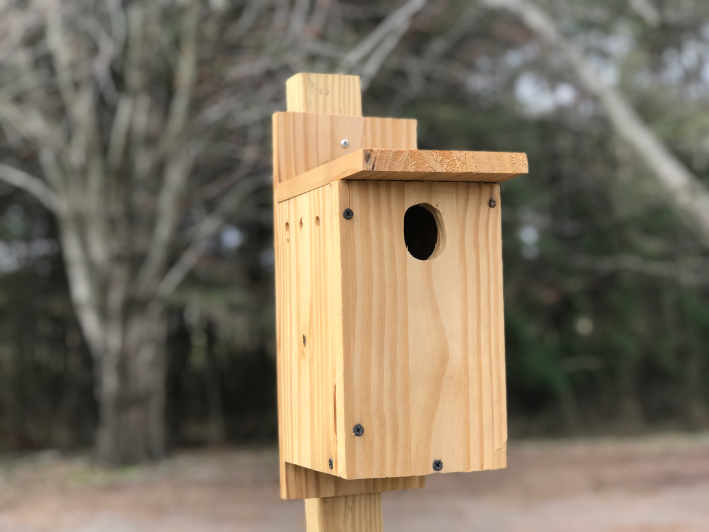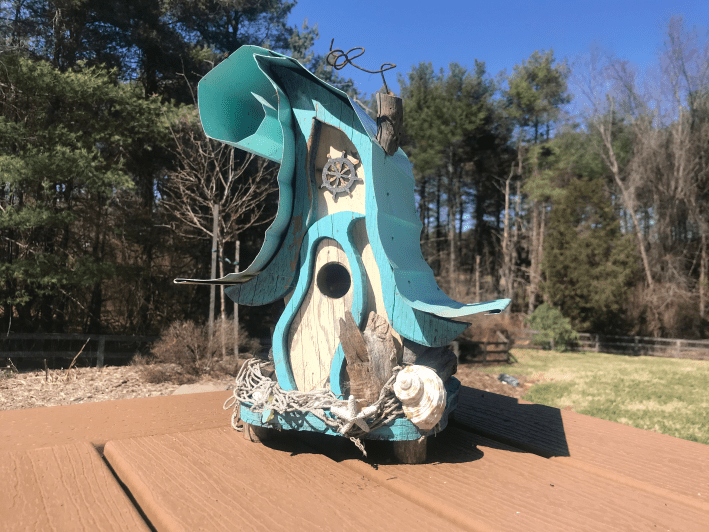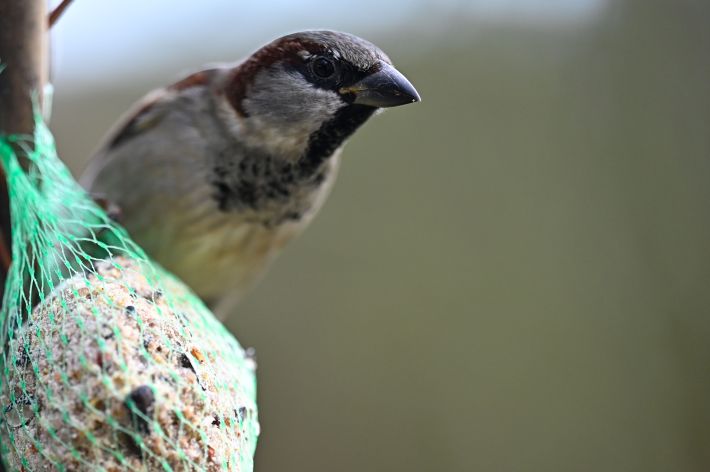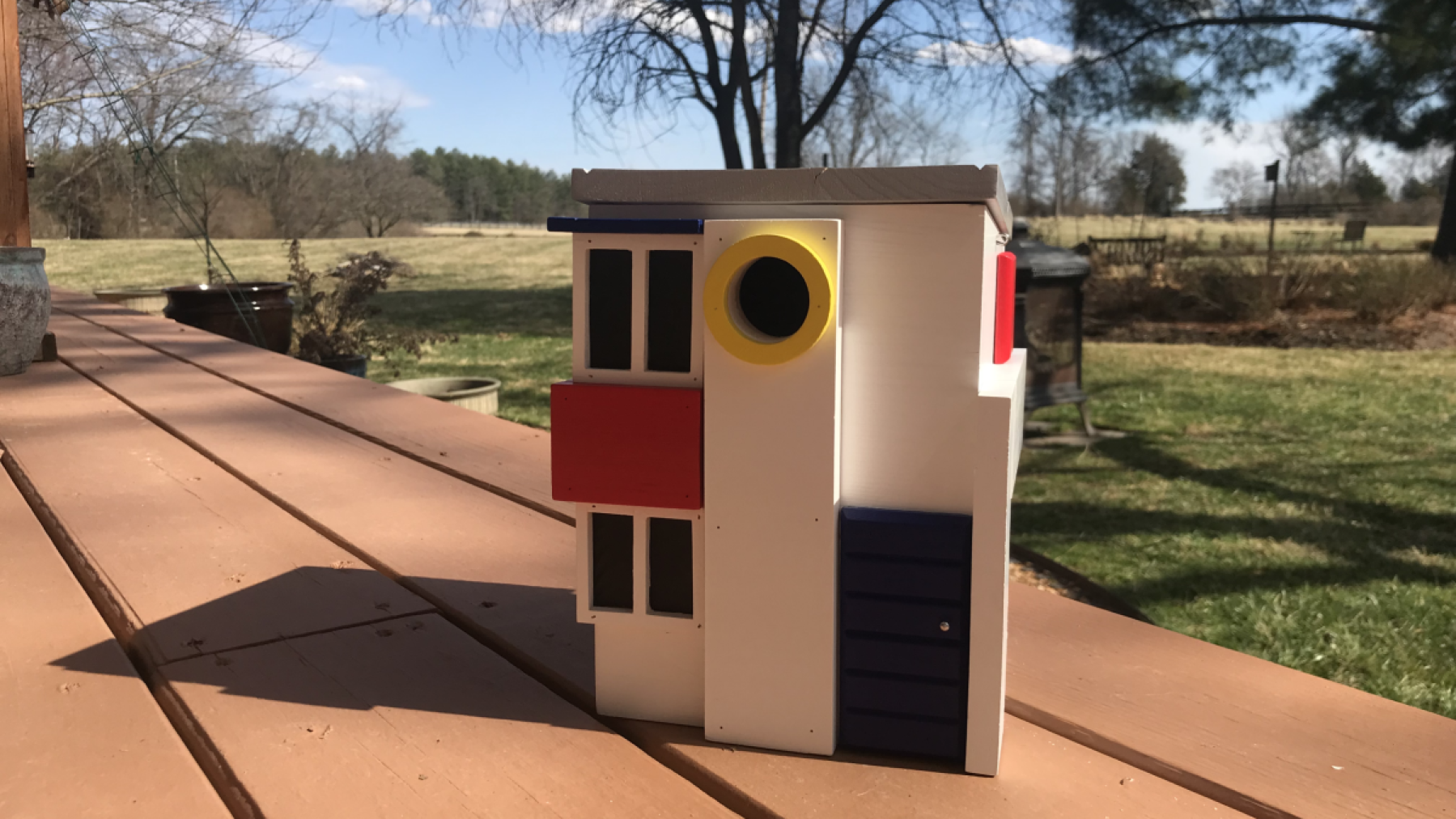Back in the winter, the goofballs of Defector dot com sent yours truly the nest box pictured above. A striking work of Swedish craftsmanship, it is more urgently and significantly a nest box, for birds. It converts very cleverly to a feeder for winter months, via an included set of pegs and a removable roof, but because the instructions are downright IKEA-esque in their minimalism, and because those instructions were shipped inside the interior of the box, and because there is no very obvious way to gain access to the interior of the box, for most of the last few months I thought it was just a nest box. Still! It is a very nice nest box, and a bird couple will be lucky to raise up a family of hatchlings inside it.
I bring this up because now is the time, my friends, when you must divert some of your limited mental bandwidth to the job of helping our bird pals by putting out some nest boxes. The National Wildlife Federation and the beloved Cornell Lab of Ornithology agree: All kinds of native songbirds need help finding quality accommodations. Grand-scale habitat loss is part of the problem, of course, but so too are invasive species, like the House Sparrow, which aggressively compete for the sorts of homes liked by, for example, native bluebirds and swallows. And then there are the annoying homeowner practices of removing debris piles, knocking down dead trees, cleaning out dense brush, and otherwise eliminating from nature the spots where cute little wild animals like to live. Housing supply is an even greater problem in the bird world than it is in the human one.
Caring about all of this environmentalism business is not a prerequisite for getting into the nest box "scene." Putting out a nest box and watching it get used by birds is cool, even if all they're doing in there is perching and roosting and making a big mess. When you get a couple birds to build an actual nest in there and lay some eggs, my friends, that rules. And when you achieve the highest tier of nest box stewardship—successfully attracting a specific kind of bird, by intentionally choosing the right kind of box and placing it in the right spot at the right time—that is a deeply bitchin' experience. So far in my life I have successfully attracted Eastern Bluebirds to a specific nest box, and they have now returned to it for two years. I have bluebirds all over the place, and it's really great. I have also unsuccessfully attempted to attract Great Crested Flycatchers and Tree Swallows, but even the failures are fun: I took down the house I intended for Tree Swallows and stashed it near my porch, whereupon it was immediately occupied by a mating pair of Carolina Wrens, the absolute sweetest and happiest songbirds in the world. The other box appears to have become an extremely rowdy social club for House Finches. All of this suits me just fine.
You too can liven up your neighborhood, by helping provide our little bird pals safe and warm places in which to raise their young. And it will not even require that you purchase a fancy and complex Swedish-built bird home that makes your own home look disconcertingly bare-bones by comparison. Cornell's NestWatch website has approximately one million DIY nest box designs, ranging in complexity from some crap you nestle in the ahh, like the crotch of a tree (Mourning Dove), up to some genuinely complicated projects (Great Blue Heron) that will be rewarding for skilled carpenters and so forth. I am extremely not handy or skilled at all, and yet I have built seven different boxes using the instructions from this website. Here is one:

This piece of crap nest box which I made using a miter saw and a drill and some old screws has been the happy home of nesting Eastern Bluebirds for consecutive seasons! The Great Crested Flycatcher box which has become Roadhouse but for finches was built using a circular saw and the leftover wood from the Eastern Bluebird box project, and took me all of 40 minutes to complete. I did an American Robin nest box last year (no takers, unfortunately), because I felt that I had leveled up in my carpentry skills and the box design involves fancy non-right angles. Wow!
If you don't feel like making a whole crafting project out of this, you can also buy nest boxes at your various home supply stores, and these will surely kick the shit out of whatever you'd make at home. It's fine to just buy a box or two and put them in places where birds can find them. The birds absolutely will not care at all that you did not personally cut the wood that forms the walls of their house. Also boxes that you buy at the store will look much fancier than boxes you make in your garage, so you can put them in your garden or whatever and they will look cool, whether birds nest in them or not. Behold!

Whatever you choose, here are some tips I have learned from putting up nest boxes all over the damn place:
Not every box is going to work right away. But! You can just move them around and keep trying. This spring I am moving the Great Crested Flycatcher box closer to the only spot where I have actually spotted a Great Crested Flycatcher, and I am optimistic that I will have better luck. Try out a bird box this spring, and if it doesn't attract any residents, simply move that sucker in the summer. Some birds—the Eastern Bluebird and the Carolina Wren, for example—will make multiple nests in a year before shifting into winter mode, so it's worth trying a few different spots if the first doesn't pay off.
Consider the fledglings. It's important to remind yourself that birds use nest boxes to make nests, and the things that grow in nests are tiny little baby birds called hatchlings. Hatchlings hang out in the nest for a little while before becoming fledglings, and fledglings are vulnerable little morons who think they can fly but mostly cannot. Like a big stupid idiot I placed my Eastern Bluebird box over a patch of lawn that I generally prefer to keep mowed through the summer, and mowing gets real scary when those fledglings are starting to get bold and frisky. It's better to put your nest box over a garden or mulch bed or at the edge of woods, where there will be a soft landing spot for the fledglings and also where they will not be mowed to death.
Consider the predators. I don't have to worry about cats or raccoons where I live, but I do have to worry about hawks. It's a good idea to place your nest boxes (and your bird feeders and your bird baths) under a tree or an awning of some sort, so that the birds can come and go from the entry hole without worrying too much about Death From Above. If you've got outdoor cats in the area, you will have to think about installing baffles or guards on your nest boxes, and placing the boxes away from areas where cats can leap down onto them. Cats and raccoons sit on top of the boxes and use their clawed forepaws to reach down into the entry hole and terrorize anything living inside. A nice long roof that overhangs the entry hole by at least four or five inches can usually thwart that, but there are also some cool things you can install that will do the trick. There are some useful instructions for this kind of thing here.
Consider the invaders. House Sparrows are beefy and extraordinarily rude songbirds that are native to Europe but were introduced, by morons, to North America. They travel and settle in huge groups, boss other birds around at feeders and baths, and prefer exactly the sorts of homes that would otherwise be used by beautiful native species, who face enough problems already without these intruding Eurotrash jerks moving in and taking up all the affordable housing. They're not the only invaders—European Starlings can also go to hell—but you will have to be on alert for House Sparrows moving into your nest boxes, because they are absolutely everywhere.

I have a sturdy store-bought nest box in my garden that was intended for Eastern Bluebirds but which is secured, every year, by House Sparrows. I must admit, this is a significant pain in the ass. Simply removing their nesting materials will prevent them from laying eggs, but it will not prevent them from defending the box to the death and chasing off all the better birds. So I have simply conceded that this house will never be used by better birds. But I also cannot remove the box, because if I do the House Sparrows will simply fight to the death for the next nearest box, which every season is being used by other, nicer birds.
So I trudge out there noisily every couple of weeks, rap on the side of the box to give any birds a chance to bolt, and then open it up and sweep out all the nesting materials. It's not an ideal situation, but it maintains the peace between the various nesting birds. The Eastern Bluebirds get to nest in their box, the Carolina Wrens get to nest in their box, and the stupid asshole House Sparrows get to think they are nesting in their box, when really they are not.
Available nesting materials encourage nesting. Many birds will make orderly nests out of whatever loose junk is around, but a few bird species like to raise their hatchlings in luxury, and will pad out their nests with only very specific materials, like soft feathers. Here is a nice trick: Use a clothespin or a binder clip or even just some tape to bundle up some soft feathers (you can buy little bags of feathers at most craft stores) and then set the little bundle on top of the bird house. This will encourage some of the fancier box users to give your little box a closer inspection. You can also do this with pine needles or grass clippings or whatever—the little birds will appreciate any shortcuts you provide!
Spring is the right time to start setting up your nest boxes. Pay no attention to the calendar, for I assure you that the Tufted Titmice do not know at all that it is allegedly still winter right now. If there are daffodils popping, it is spring. Now is when the songbirds start scouting for homes. Last year's fledglings are this year's horny twenty-somethings, but pads are perpetually in short supply. Help them out, won't you? Screw a nest box to a pole or a tree, or affix it to a shaded stump, grab a pair of binoculars, and make a whole hobby of it.






